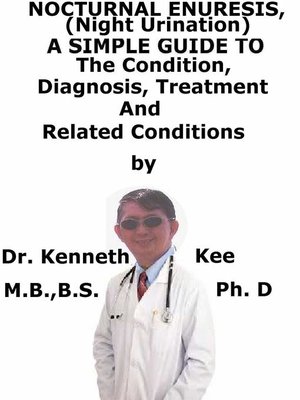Nocturnal Enuresis, (Night Urination) a Simple Guide to the Condition, Diagnosis, Treatment and Related Conditions
ebook
By Kenneth Kee

Sign up to save your library
With an OverDrive account, you can save your favorite libraries for at-a-glance information about availability. Find out more about OverDrive accounts.
Find this title in Libby, the library reading app by OverDrive.



Search for a digital library with this title
Title found at these libraries:
| Library Name | Distance |
|---|---|
| Loading... |
Nocturnal enuresis (NE) is when a child after age 5 or 6 wets the bed at night, more than twice a week.It affects boys more than girls and has a prevalence of 15%.There are 2 types of Nocturnal enuresis:1. Primary enuresis.Children who have never been consistently dry at night for more than 6 months.This most often happens when the body makes more urine at night than what the bladder can retain, and the child does not wake up when the bladder is full.The child's brain has not learned to respond to the signal that the bladder is full.This is the most frequent reason for nocturnal enuresis.This is the recurrent involuntary passage of urine during sleep by a child aged 5 years or older, who has never achieved consistent night-time dryness.This may further be subdivided into:a. Primary nocturnal enuresis without daytime symptoms: children who have enuresis only at night.b. Primary nocturnal enuresis with daytime symptoms: those who also have daytime symptoms, such as urgency, frequency, or daytime wetting.2. Secondary enuresis.Secondary enuresis indicates children who were dry for at least 6 months, but start nocturnal enuresis again.There are many reasons that children wet the bed after being fully toilet trained.It might be physical, emotional, or just a change in sleep.The cause of nocturnal enuresis is believed to be multi-factoral and that include:Genetic CausesPsychological Causes1.Nocturnal polyuria2.Small functional bladder capacity3.Detrusor instability4.Disorder of sleep arousal5.Delay in maturation6.Global maturation delaySocial CausesSymptoms:FrequencyUrgencyDaytime wetting.Difficulty with poor stream.Pain on urinationThe doctor should assess for underlying cause:1.Constipation.2.UTI.3.Diabetes mellitus.4.Behavioral and emotional difficulties.5.Child maltreatmentDiagnosis:The doctor should investigate (and treat) daytime symptoms before addressing enuresis - e.g., symptoms suggestive of diabetes, UTIs or constipation.The doctor should consider asking parents to keep a diary of the child's nocturnal enuresis patterns, daytime symptoms, toileting pattern and fluid intakeA child should have a physical exam and a urine test to rule out urinary tract infection or other causes.No further investigations are needed if urinalysis is normal.Nocturnal enuresis can be very distressing, especially for older children.It may lead to social isolation, bullying and low self-esteemConservative therapies1.Explanation and reassurance2.Advise children to avoid caffeine-containing drinks before bedtime.3.Manage constipationSimple behavioral therapies:More children become dry when given rewardsIf the child wakes at night, encourage them to use the toilet before returning to sleepUrotherapy involves:1.Timed voiding2.Advice on good hydration3.Reduction in diuretic fluids4.Avoiding fluid intake before sleep5.Emptying the bladder before sleepConstipation should be treatedEnuresis alarms:It serves as a conditioning device using a noise to link the stimulus of a full bladderTreatment is continued for 3-4 months and stopped when the child has remained dry for a consecutive three weeksDesmopressinDesmopressin should be given first-line to children over 7 years of age when rapid control is requiredOtherwise it should be used second-line after an alarm has been tried.Tricyclics antidepressant is effective at reducing the number of wet nights during treatmentImipramine is approved for use in treating nocturnal enuresis in children aged 6 years and above but is reserved for treating resistant casesCombination therapy with anticholinergic treatment increases the efficacy of treatment.TABLE OF CONTENTIntroductionChapter 1 Nocturnal EnuresisChapter 2 CausesChapter 3 SymptomsChapter 4 DiagnosisChapter 5...







